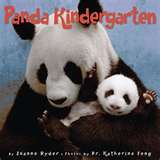 It’s the end of August, so before we pull out the books about apples, pumpkins, and leaves changing color, let’s give one last hurrah to summer with Suryia Swims! How an Orangutan Learned to Swim.
It’s the end of August, so before we pull out the books about apples, pumpkins, and leaves changing color, let’s give one last hurrah to summer with Suryia Swims! How an Orangutan Learned to Swim.
“Their evolutionary history has taught (orangutans) to beware of dangers, such as crocodiles, that lurk in the water. Because of this, the intuition that would have encouraged orangutans to swim never developed.” Orangutans like Suryia don’t swim, but then again, Suryia is not a typical orangutan. He lives in South Carolina at a wildlife preserve called T.I.G.E.R.S. (The Institute for Greatly Endangered and Rare Species) instead of Southeast Asia like his wild counterparts. His best friend is a dog named Roscoe. And when the tigers, the otter, the elephant, and the tapir go swimming in T.I.G.E.R.S. pool, Suryia jumps in, too.
The photographs by Barry Bland are incredible. Suryia cuddles leopard cubs in the water and dives for plastic rings, things an orangutan would typically never do. In the safe wildlife preserve that Bhagavan “Doc” Antle founded, animals don’t have to struggle for survival, so “their intellect and curiosity can grow”. Seeing all the other animals have fun in the water may have encouraged Suryia to overcome his fear, too. Sounds a bit like a good classroom, doesn’t it?
Use this nonfiction picture book to teach the Common Core State Standard of Key Ideas and Details: students retelling the who/what/where/when/why of a text. After you share this book with your students, discuss the information found in the author’s note. Why is it so unusual for Suryia to swim? Why do you think Suryia took the plunge? At our library, we have found that Storyboxes or magnetic Storyboards are great vehicles for retelling. We find puppets or stuffed animals of the characters in the book, or make copies of open-source images and glue old magnets to the back. We put the characters and the book in a center for students to retell or act out the details they’ve learned. Students can use a puppet orangutan and say why he’s afraid of swimming. One by one, students can put Roscoe the dog in a pretend pool, then Bubbles the elephant, Tonks the tiger, the baby bear Ondar, etc. and retell the details of the book. Go to suryiaandroscoe.com to see video clips of this amazing, swimming orangutan and his best animal friend. Suryia Swims! written by Bhagavn “Doc” Antle with Thea Feldman and photographs by Barry Bland will reaffirm for your students that anything is possible!



